5 Things to do in Cape of Good Hope (+ Facts and Prices)

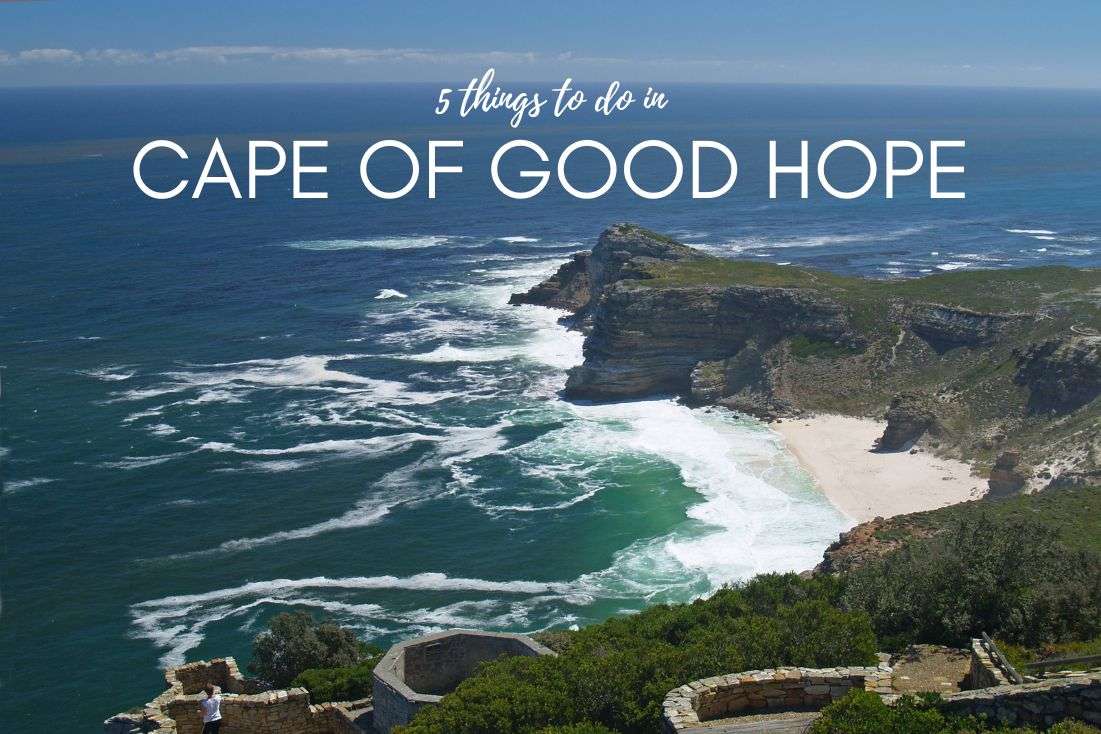
Cape of Good Hope is the number one destination in South Africa! It might not be the southernmost tip of the African continent, but it’s mesmerizing. Which trails are the best, how did the Flying Dutchman get there and where are the best beaches? Let me tell you.
You might also be interested in reading:
- 7 Things to Know Before Traveling to South Africa
- Shark Cage Diving in South Africa: 3 Stages of My Heroic Descend Among the White Sharks
- 7 Unique Places to Visit in South Africa
- Best 12 Hotels in Cape Town: Luxury, Comfort and More
- Table Mountain, South Africa: 9 Facts You Need to Know
1. Cape of Good Hope Trail
- Difficulty: Easy
- Distance: 3.5 km (2.17 mi); from the parking lot and back
- Elevation Gain: 186 m (610 ft)
- Time: Approximately 1.5 hours
Now that we've cleared that up, let’s move to the actual visit. The Cape Point is a National Park. That means, there is a ridiculously small entrance fee and nice, clean facilities on the site. We arrived at the main parking lot with a restaurant and the funicular railway station, which is basically in the center. We decided we need to visit the Cape of Good Hope first and so we took the short trail down the cliffs. There are wooden or stone paths everywhere and it is all visible from distance, so even the biggest idiot gets there safely. As I saw the wooden sign at the beach at the end of the trail I knew we’ve reached the end. After several attempts to get the best Insta-shot, preferably without other people (impossible), we headed back to the parking lot.
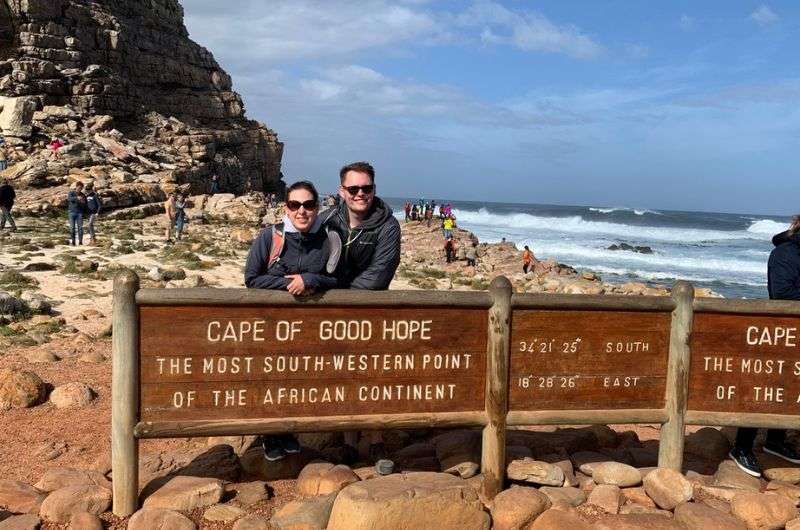
Mandatory Photoshoot
2. The old lighthouse and the new one
You can see the old lighthouse right from the parking lot, but that’s not the only one. I love to do my research in advance, so I knew that this spot wasn’t exactly the best (all the dead sailors could tell), so they decided to build a new one further on the cliff. But first things first.
There are three ways to get to the old lighthouse:
- Paved path along the coastline
- Straight paved path from the parking lot
- Flying Dutchman Funicular Railway
It’s not very hard to get to the top, but it might be rough for those who are out of shape. Karin and I were alright, but on this trip, I decided to treat my mother with a nice vacation (by the way, trust me, it’s not a good idea if you want to maintain the good relations with your parents) and she had a hard time climbing the stairs at the end. Nevertheless, the scenery is so stunning, you’ll be stopping every now and then to soak it in anyway. It’s the most romantic place I’ve ever been to, in a Wuthering Heights kind of sense. The rugged cliffs, strong wind, and the roaring ocean would make a perfect setting for some period piece. For the ultimate breathtaking experience take this trail.
Lighthouse Keeper’s Trail
- Difficulty: Easy
- Distance: 3.5 km (2.17 mi); from the parking lot and back
- Elevation Gain: 238 m (780 ft)
- Time: Approximately 1.5 hours
This hike connects the old and the new lighthouse and offers the best possible scenery. We walk to the end of the peninsula and just stood there in awe. Below us only steep cliffs dropping down 300 m (980 ft) into the ocean. The vast ocean waters cover the horizon, and you realize there is only the Antarctic on the other side of the mass… mind-blowing.
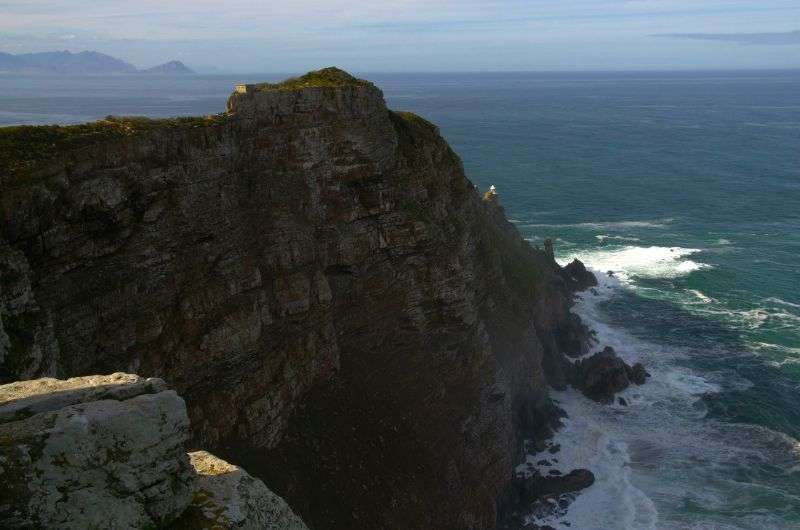
The feeling, when you're standing at the end of the world...
Flying Dutchman Funicular
The funicular railway gets you up to the lighthouse in 3 minutes and it’s barrier-free. Now you’re surely curious about the name. It would be weird if a place like this, with countless shipwrecks along the coast, wouldn’t inspire any tell tales.
There’s one about the Dutch galleon from the 17th century. Captain Hendrick van der Decker supposedly didn’t want to turn back despite the storm and decided to sail around the cape. When all of a sudden, an angel appeared on the deck and the furious captain shot her. From that day the crew is condemned to sail through these haunted waters every day over and over again.
Funny thing is that countless fishermen and sailors have reported seeing the ghostly galleon with its crew seeking someone who would help them deliver their letter home to their families. Everyone who approached them ended up dead though. Bummer. Anyhow, the funicular should be safe.
Prices:
Adults:
- One way: 50 ZAR (3 USD | 2.50 EUR)
- Return ticket: 75 ZAR (5 USD | 4.50 EUR)
Kids (6-16):
- One way: 35 ZAR (2 USD | 2 EUR)
- Return ticket: 45 ZAR (3 USD | 2.50 EUR)
- Children under 6 years travel for free.
Opening times are the same as for the National Park.
3. Hit the beach(es)
One of the most beautiful beaches is to be found around the peninsula. With fine white sand and usually empty, it might be tempting. However, it’s not advisable to swim there—we didn’t. There are strong tides, no lifeguard and the water is frankly quite cold. But it’s a nice walk with majestic scenery. So, forget about swimming, but you can draw your names in the sand or take a cheesy couple photos or do any other crazy stuff people are doing these days. Or... you can make a reenactment of the famous Jake and Rose door-scene, I think that you wouldn’t even have to act you’re freezing. Personally, I’m okay with a walk. Here is a list of the best beaches in Cape Point:

Me imagining myself as a Heathcliff
4. Shipwreck trails
Talking about beaches, I totally dig the shipwrecks there. It’s thrilling when you’re walking on the beach a find the hundred-year-old torso of a ship. The Trails lead through the thick fynbos which makes it a pleasant walk even without the wrecks. There are two trails, both starting at the Olifantbos parking lot. I must say it’s all very well marked, so you couldn’t stray off from the road unless you do it on purpose ?
Thomas T. Tucker Trail
- Difficulty: Easy
- Distance: 3 km (1.90 mi); from the parking lot and back
- Time: Approximately 1.5 hours
This is the shortest and most accessible one. It’s marked by yellow and leads you down to the beach towards the wreck of SS Thomas T. Tucker. The US ship was built during WW II to carry troops and weapons, but in 1942 it shipwrecked on these shores trying to avoid German detection boats. Since then, the local birds seized the wreck and declared it their territory.
Sirkelsvlei Trail
- Difficulty: Moderate
- Distance: 10 km (6.30 mi); from the parking lot and back
- Time: Approximately 3 hours
We decided to continue onto Sirkelsvlei Trail. This loop trail leads through various landscapes from rugged cliffs and sandy beaches to Sirkelsvlei pan, home to many rare animals such as bontebok and hartebeest, if you’re lucky you can even spot an ostrich. And of course, several shipwrecks. I mean, if I was a boy, I would spend the entire afternoon discovering the shipwrecks. For a family afternoon, take this as a warning... or a recommendation. It depends how much time are you willing to spend there.
5. Marvel at Floral Kingdom… and fauna territory
The Cape of Good Hope is part of the Cape Floristic Kingdom. Same as Table Mountain, the Cape is home to hundreds of indigenous endemic plant species. The characteristic of this area is the endemic fynbos, evergreen shrubland. I’m not much of a flower guy, but this is like from another world. Completely different from what we know from Europe or US. Apart from the flowers, you can admire a bunch of animal species: lizards, snakes, birds, tortoises, whales, and even antelopes and mountain zebras. And the sneakiest ones: baboons (more about those bastards later).
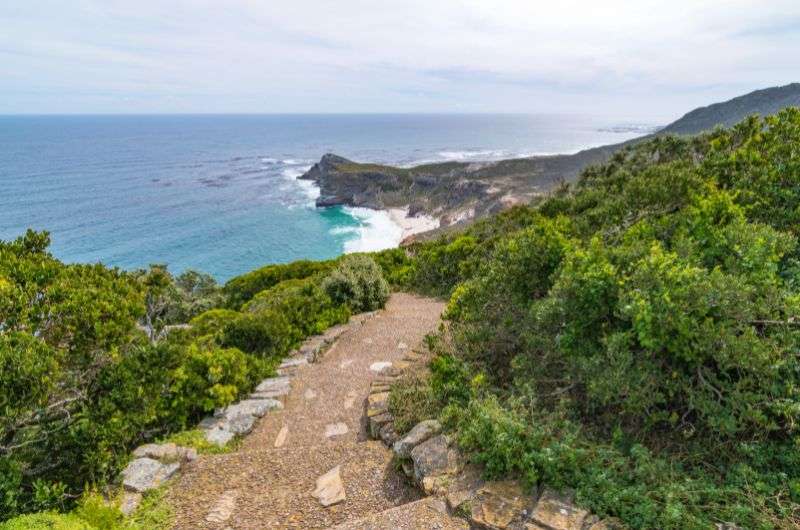
Diaz Beach
Our tips for Cape of Good Hope:
- Where to eat: Tiger’s Milk Muizenberg
BONUS: Boulder Beach
Technically it’s not Cape Point, but it’s in Simon’s Town, halfway on the way back to Cape Town. The Boulders Beach is home to colonies of African penguins, endemic to the southeast of Africa. You don’t need a map, just go for the smell. That’s awful, to be honest, but the penguins are cute and funny to watch. Just remember, they have endangered species and still wild animals. Don’t disturb them and don’t try to pet them.
Warning #1: Cape Point Weather
The weather at Cape Point is rough as well as its waters. There are strong coastal winds and especially in the winter months (June to August), it gets a bit chilly. It might be a good idea to pack a light jacket. After the whole day there, we felt like after a whole day skiing—with weathered faces and weirdly exhausted (although the hikes are not so challenging).
Warning #2: Cape Point Baboons
Last but not least, the baboons! They are cute from the safety of the car, but far less cute when you step out of it. Karin wanted to take a cute funny photo with these rascals but ended up too scared to approach them closer than 5 feet. I tried, but they know the alfa male when they see one, so they scattered. And as any other monkey, rude and bold. They are attracted by food, and they steal everything that isn’t chained to your body. If you don’t watch your bag, it will be lost faster than Nixon’s career after Watergate. And when that happens, believe me, you don’t want it back anymore. These bastards have long, and sharp canine teeth fit to kill you in a matter of seconds. But in some ways, the baboons are the same as people…kinky.
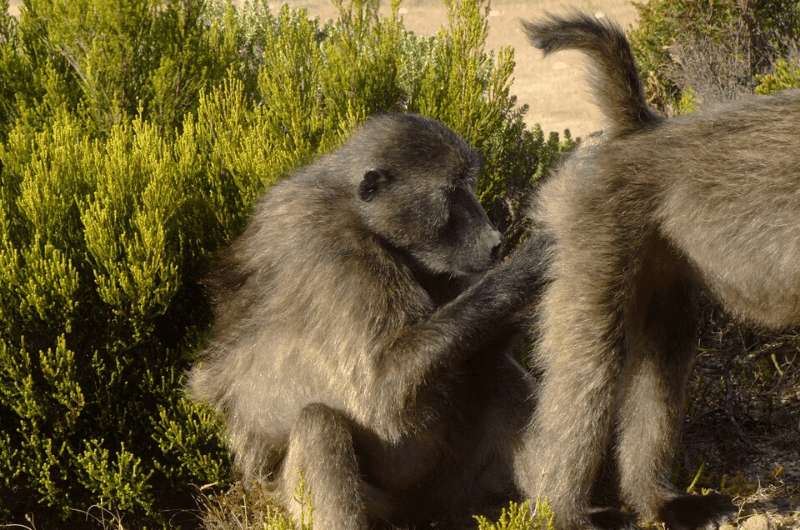
Shameless creatures...
Quick fact-check:
Cape of Good Hope is not the southernmost point of the African continent
Everyone lied to you! Yes, Cape of Good Hope is not the southernmost point. It is Cape Agulhas, that’s the place where the Atlantic Ocean meets the Indian Ocean. I’m telling you, it’s steamy. ? No, seriously, it’s a pretty cool experience to put each foot in a different ocean. But back to Cape of Good Hope. Nowadays, when we know all that stuff, all the brochures, and signs mark the spot as “the most south-western point”. Well, it’s not the same.
Bartolomeu Dias didn’t name it that way
Sneaky liars those high school teachers… Let’s get it straight. Yep, Bartolomeu Dias was the guy who “discovered” it. But it was on his way back to Portugal and he originally named it “the Cape of Storms”, rightfully to be honest. The traitorous currents and strong winds have caused countless shipwrecks. But the Portuguese King didn’t like that very much, because he was a smart guy and he realized this was not the best marketing copy for the trading route to India. To enhance the trading development, he decided to rebrand the cape name for something optimistic. Hence the Cape of Good Hope.
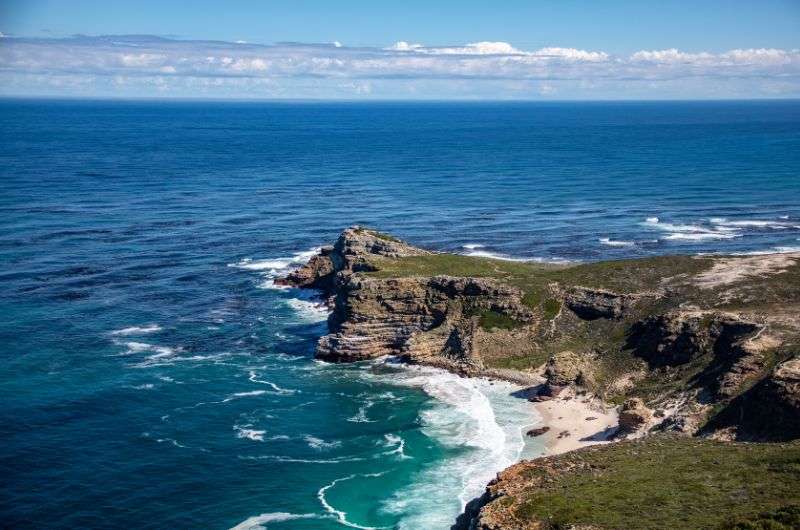
The view of the Cape of Good Hope from Cape Point
There are in fact two capes
Ha, even more confusion. The Cape of Good Hope is located on the Cape Peninsula in the western part of False Bay in South Africa. But there are two capes at the end of the Cape Peninsula. If you look at it, the Peninsula looks a bit like a chicken leg, where the Cape of Good Hope represents the left side of the joint and Cape Point the right one. But, to bring more chaos into it, the Cape Point National Park is also the name of this entire southern area belonging to Table Mountain National Park.
Opening times:
- 6 am to 6 pm (October – March)
- 7 am to 5 pm (April – September)
- You should exit the NP by Sunset at most. There’s a 500 ZAR (32 USD | 28 EUR) fine for a late exit.
Prices:
- Adults: 340 ZAR (21.50 USD | 19 EUR)
- Kids (2-11): 170 ZAR (11 USD | 9.50 EUR)
This post contains affiliate links. I earn a small commission if you make bookings through my links, at no additional cost to you. This helps keep this blog free, thank you!


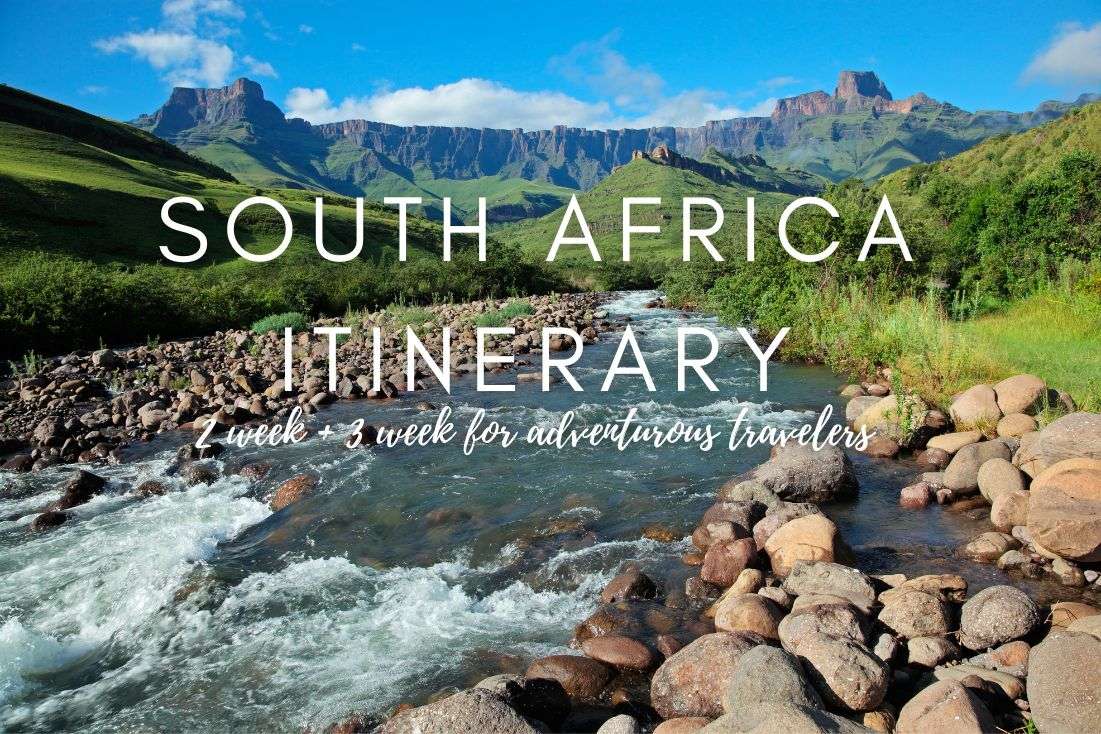
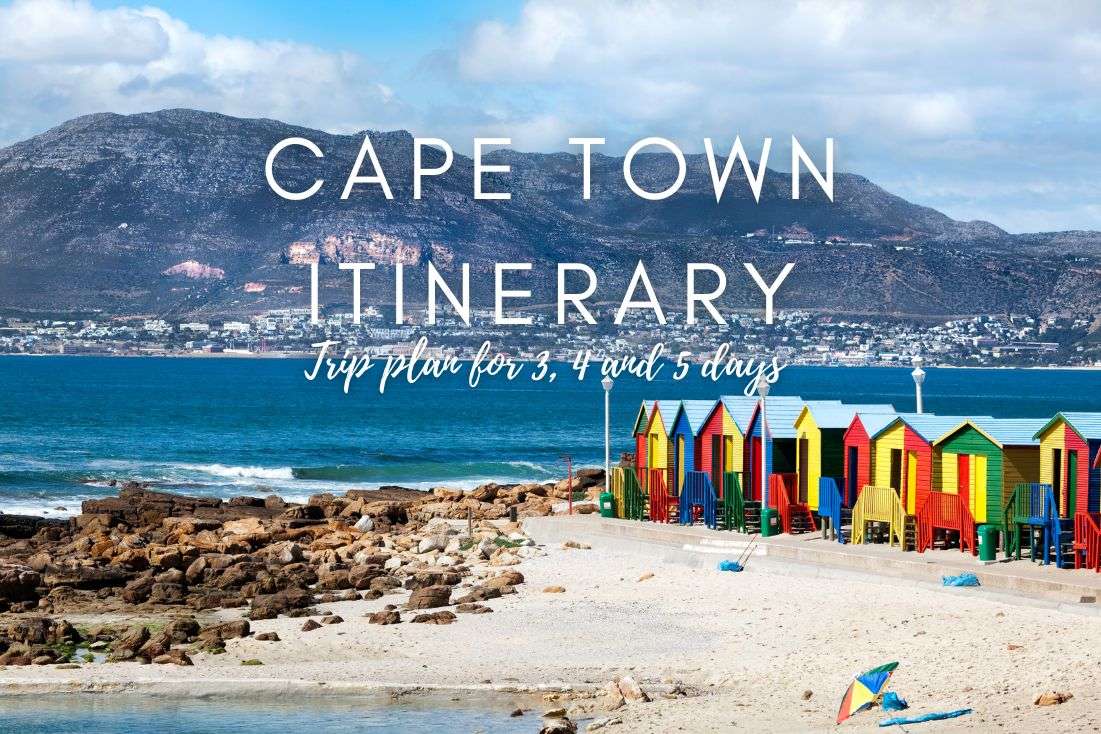






Comments | Thoughts? Give us a shout!